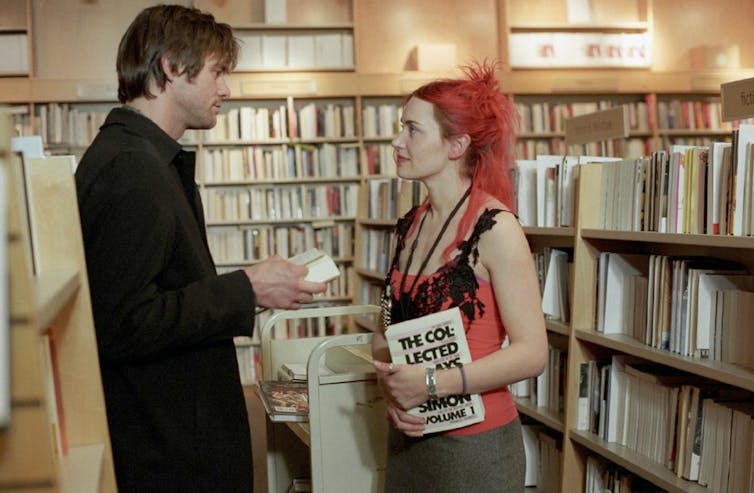This article contains spoilers.
Heartbreak is a universal experience. When a heart breaks, we vacillate between hope and fear, anger and denial and a thousand fragmentary moments of grief. Uninvited memories persistently invade our days: memories of what was, what could have been and what will never be.
When writing Eternal Sunshine of the Spotless Mind (2004), Charlie Kaufman could not have known about the seismic impact of social media in years to come. How we now lurk on our former lovers’ profiles, view their photos, analyse their posts and remove images – metaphorically wiping the slate clean and willingly deleting our past.
This relatable angst of ridding ourselves of past memories of heartbreak is the premise of director Michel Gondry’s masterpiece, which is 20 years old this week.
With a non-linear narrative steering a rollercoaster script, this quirky, nebulous, joyous then rueful story is not for those who like their love stories simple. Gondry’s emotive film dares to confront the not so happy-ever-afters in a dark fairy tale which meditates on love and memory and the discombobulation of a broken heart.
We first meet Joel (Jim Carrey) as he abandons his daily commute for the opposite platform, to catch a train heading for the coast. It’s there, on a desolate grey beach, that he first sees Clementine (Kate Winslet), with her colourful blue hair. She introduces herself on the return journey with a sharp punch to the arm and a direct, unflinching intensity.
Shy, insular Joel is hooked and so are we. With the meet-not-so-cute established, the whirling storyline begins to loop and bend around time. Is this the beginning of the love story, or the end?
Can’t get you out of my head
We duly witness Joel’s agony and ecstasy through a collection of memories which ultimately end with the loss of Clementine. With her gone, Joel’s life loses its colour and verve.
He’s galvanised to win Clementine back, but is confused when she doesn’t recognise him. This leads him to discover that Clementine has had their entire relationship erased from her mind by the avuncular Dr Mierzwiak (Tom Wilkinson) and his eccentric team: an unusually chaotic Mark Ruffalo, Elijah Wood and Kirsten Dunst. When Joel decides to undergo the same procedure to shut out his own pain, the chaotic emotional conflict deepens.
The space between waking and dreaming become progressively intertwined with nightmarish depictions of Joel’s brain cleansing. Acid-coloured set design that exaggerates childhood memory, nightmarish Kafka-esque corridors of the mind and circus-like distortions exacerbate the effect.
In this anything-can-happen landscape, Joel’s desperation to hang on to his memories of Clementine becomes a driving force and the audience roots for their love, however dead it has seemed, to live on. We hope that they will outrun the mind-filtering process and come out ready to give love another try.

In real life, Gondry’s low-key, laidback and friendly persona enabled him to persuade big stars Jim Carrey and Kate Winslet to sign up for the quirky premise and his own relatively untested directorial vision.
Up until then, his main gig had been as music video director for artists including The White Stripes, Bjork and The Foo Fighters. He had form as an imaginative and experimental auteur, but the one previous cinematic outing that he and Kaufman had created, the Tim Robbins and Patricia Arquette comedy Human Nature (2001), resulted in an underwhelming box office and a confused set of critics.
When Carrey first met Gondry to talk about the project, he was reportedly in a state of brokenness after coming out of a relationship with fellow actor Renee Zellweger – something that Gondry urged him to preserve for the character of Joel. Gondry saw the actor as the opposite of the ebullient, anarchic character he mainly portrayed and as someone who stood apart from the crowd. He cited a lonely moment he had once seen of Carrey standing to the side during the credits of Saturday Night Live, as others danced and celebrated.
Winslet, doyenne of many a period drama by that point, took on the more conventional Carrey-esque role of Clementine, showcasing hair of many colours throughout the movie, and a changeable personality to match. Her performance was revelatory and ultimately the gamble of going against casting type paid off, winning her a best actress Oscar nomination.
Gondry and Kaufman won the Oscar for best screenplay. In later years, Kaufman urged an audience of writers to subvert narrative structure with advice seemingly tailored to his experience of Eternal Sunshine: “your dreams are very well written. Approach your work like your dreams would and throw away conventional approaches.”
“A light heart lives long” intones Shakespeare in Love’s Labour’s Lost, and nearly all romantic comedies end on such a “happily ever after” But in Eternal Sunshine, Gondry’s gift is to present us with love as it often really is: a messy, painful experience that fans the flames of hope, connection and intimacy in us all.

Looking for something good? Cut through the noise with a carefully curated selection of the latest releases, live events and exhibitions, straight to your inbox every fortnight, on Fridays. Sign up here.

